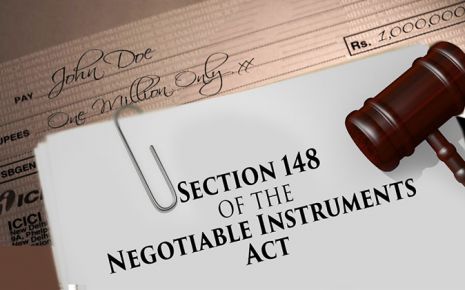Infrastructural Issues Faced By The District Courts
A visit to any lower court of the country reveals the ground reality in our
country about the judicial institution. It enlightens us about the pathetic
conditions in which the courts functions for the administration of justice. One
would notice lack of adequate facilities like toilets and drinking water
especially for women, senior citizens and children on the court premises. The
more diabolical thing is that there is an inadequate number of lawyer’s chamber.
Litigants are the people whose needs should be catered primarily as the courts
owe their existence to them and the absence of such basic facilities on the
court premises leads to the augmentation of difficulties for the litigants.
According to the National Judicial Data Grid, there are approximately 3.3 cr.
cases pending in the Indian courts, in which 2.84 cr. are pending in the
District Courts and the backlog is 43 lakh and 57,987 in the High Court and
Supreme Court, respectively. The five states which have the highest pendency are
Uttar Pradesh, Maharashtra, West Bengal, Bihar and Gujarat.
At the rate the cases are handled civil cases will never be solved and criminal
cases will take more than 30 years to be solved. There is one judge for 73,000
people in India which is even times worse than the United States of America. The
long list of cases hung on the notice board does not ensure that the case will
be presented before the Judge. Common reasons for such lagging of cases can be
vacancy of judges, prolonged strikes by lawyers or the court staff, government
holidays, lack of adequate infrastructure etc. This also creates problem for the
people under trial, especially in cases of non- bail able offences, as it is
hard for them to get bails and many even more than their sentence because of
this. Over the last few years, the relevance of judicial infrastructure has
started to receive more emphasis particularly by judiciary itself.[1]
While delivering a lecture on topic Technology, Training and Infrastructure:
Key to Speedy Justice the Chief Justice of India said “The infrastructural
gaps shall not be allowed to multiply and should be addressed at the earliest
opportunity before it leaves a deep scar on the administration of justice and it
becomes too late to act wisely. Fiscal constraints is no excuse. The need is to
strengthen the judiciary as a consequence of which the justice delivery system
becomes fast, qualitatively responsive and serves the purpose of justice.” He
also said that there is a need to widen the network of courts to increase
geographical reach of common man, to provide basic facilities to litigants and
required facilities for the lawyers. He also said, “Judicial infrastructure
includes the infrastructure for bar and litigants which are the backbone of
justice delivery system.”[2]
Categorization Of Infrastructure:
The definition of infrastructure for the purpose of court premises can be
comprised as: Physical Infrastructure, which may include court buildings, rooms,
elevators, facility for drinking water etc. Secondly, The Personnel
Infrastructure, which may include judges, court staff and lawyers. Thirdly, The
Digital Infrastructure, which may include, court websites, e-courts, mobile
applications etc.
The physical infrastructure of the courts is in a pathetic condition considering
the state of court premises which were built earlier, they lack basic facilities
like toilets, or even if the toilets are built they are not cleaned on a regular
basis and may cause gut infections, lung and skin diseases, sexually transmitted
diseases etc., facility of crèche for the women judicial officers or litigants
because of which they’re forced to leave their infants either with some relative
or hire a babysitter as a consequence of which the babies are not looked after
efficiently, some of the court rooms even lack adequate lightening causing
problems for the judges as well as lawyers.
The personnel infrastructure of the courts need ample number of judges, which is
one the major problems faced by the subordinate courts in India, the lack of
insufficient number of judges cause backlogging of cases, delay in justice,
problems caused to under trials etc. With India’s population being 1.2 billion
there should have 60,000 judges.
The figures from National Judicial Data Grid and Department of Justice tells
that there are 16,438 judges in the subordinate courts, 621 in the High Courts
and 29 in the Supreme Court of India. All the data suggests that there is
insufficient number of judges in the courts which has caused the backlogging of
3.3 cr. cases. The 120th Law Commission of India report suggests rate of
pendency or the rate of litigation as the means to fix the strength of judges,
it does not carry out the mathematical exercise of arriving the ample number of
judges. The alternative methodology suggests that the case cannot be disposed of
in a mechanical way, one or more hearings needs to take place, the evidences
should be produced before the court so that the judge could apply his mind and
give judgment. Also a proper time frame should be decided for the disposal of
cases such as 3 years. This methodology was taken into consideration by the Law
Commission of India in its 245th report on Arrears and Backlog: Creating
judicial man and women power is also the routinely assessed by the government
and courts for the strength of judges.
The digital infrastructure includes the facilities like websites of courts
inclusive of the information regarding the status of cases, mobile applications
which may inform the people about their rights and other information regarding
the functioning of the courts and other essential information. The
digitization has become an important aspect of every industry in the world
which focuses on the improvement of customer satisfaction and leveraging data
for better decision making. The legal services may gain immensely by the
digitalization.
The digitalization of legal services is essential to attract and retain talent,
increase the profits and benchmark for the counterparts. With the advent of
young professionals the need for more efficient and modern way of working
increases and the answer is to implement the best global practice of automating
processes, which would enhance case management and improve efficiency, thereby
enabling better governance and secure sharing of the information. Despite the
advantages including the transparency and increased efficiency, the fact is that
adoption rate of in country stands at just 0.1% for practice management. The
need today is acceleration of implementation and create ecosystem that can
embrace digital solutions for better output.
Infrastructure Development And Strengthen of The Subordinate Courts In
Country:
The Department Related to Parliamentary Standing Committee on Personnel Public
Grievances, Law and Justice, headed by Smt. Jayanthi Natarajan, Member of
Parliament, Rajya Sabha, decided to take up the subject Infrastructure
Development and Strengthening of the Subordinate Courts in the Country, for
a detailed examination and presented its report on February 6, 2014. The
committee noted certain points-
1. Land and Funding availability:
The committee that the government of a state is responsible for identifying and
furnishing suitable land for the establishment of court buildings etc. Also,
they must undertake construction in light of shortage of land and the Central
government must attempt to increase its contribution for the infrastructure and
ensure the timely release of funds to the state government.
2. Implementation of Centrally Sponsored Scheme:
The committee recommended that the Department of Justice must audit the
Centrally Sponsored Schemes to ascertain uneven utilisation of funds and the
development that has taken place in the states and if it has helped to speed up
the trail in the courts.
3. Computerisation of the courts:
The committee stressed upon the fact that the central and state governments must
stick to the timeline set out of the computerisation of each and every court, as
it is an essential step towards the setting up of e-courts. It also demanded for
periodic report from the Department of Justice.
4. Fast Track Courts:
After the incident of Delhi Rape Case and scams related to fraudulent investment
schemes, the need for establishment of fast track courts was realised and the
committee recommended that the fast track courts must be established at the
earliest.
5. All India Judicial Services:
The committee stressed that the Ministry must consider the establishment of All
India Judicial Services, as soon as possible, as it would benefit the
subordinate courts to increase the number of judges and help to reduce the
number of pending cases.
6. Court Procedure and Litigation Cost:
The committee noted that the procedure of courts is full of unnecessary
complexities and consume unjustifiable amount of time and recommended that the
central and state government must resolve the court proceedings at the earliest.
Conclusion:
There is a persistent lack of infrastructural development in the judiciary,
especially the subordinate courts. This problem can be more efficiently be
understood if one studies it in regards of the persons with physical
disabilities, illiterates, women, senior citizen and trans-genders. Some of the
court premises are well equipped and well designed, whereas, most of them lack
the basic facilities such as the provisions of signage, directions, maps etc.
for blind or general people, moreover to it, the entry and exit points are not
well-managed, leading to crowds. As one moves towards the rural area from the
urban areas the infrastructure of the court worsens. Basic necessities such as
clean washrooms, access to water, seating arrangement, adequate lightening were
badly neglected. At the end, it is important to note that being modern-day
courts such infrastructural standard should be maintained as they play a vital
role in enhancing the functioning of a court. Therefore, the outcome is that the
judicial infrastructure such be given priority and proper budget should be
granted for the same.
End-Notes
[1] National Courts Management Committee, NCMS Policy and Action Plan (2012)
[2] Dipak Misra, Technology, Training and Infrastructure: Key to Speedy Justice
(Sep.1, 2018, 03:50), https://economicstimes.indiatimes.com
Law Article in India
Legal Question & Answers
Lawyers in India - Search By City
LawArticles
How To File For Mutual Divorce In Delhi

How To File For Mutual Divorce In Delhi Mutual Consent Divorce is the Simplest Way to Obtain a D...
Increased Age For Girls Marriage

It is hoped that the Prohibition of Child Marriage (Amendment) Bill, 2021, which intends to inc...
Facade of Social Media

One may very easily get absorbed in the lives of others as one scrolls through a Facebook news ...
Section 482 CrPc - Quashing Of FIR: Guid...

The Inherent power under Section 482 in The Code Of Criminal Procedure, 1973 (37th Chapter of t...
The Uniform Civil Code (UCC) in India: A...

The Uniform Civil Code (UCC) is a concept that proposes the unification of personal laws across...
Role Of Artificial Intelligence In Legal...

Artificial intelligence (AI) is revolutionizing various sectors of the economy, and the legal i...







Please Drop Your Comments